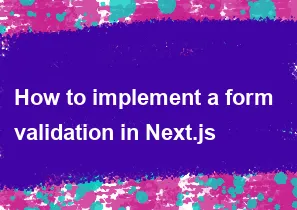How to implement a form validation in Next.js

Form validation in Next.js can be implemented using various approaches, but one common method is to use a combination of React's state management and conditional rendering. Here's a basic example using the useState hook and simple conditional rendering.
Let's assume you have a form component called MyForm:
jsx// MyForm.js
import { useState } from 'react';
const MyForm = () => {
const [formData, setFormData] = useState({
name: '',
email: '',
// add other form fields here
});
const [errors, setErrors] = useState({});
const handleChange = (e) => {
const { name, value } = e.target;
setFormData((prevData) => ({
...prevData,
[name]: value,
}));
};
const handleSubmit = (e) => {
e.preventDefault();
// Validate the form data
const validationErrors = validateForm(formData);
if (Object.keys(validationErrors).length === 0) {
// Form is valid, submit the data or perform other actions
console.log('Form submitted:', formData);
} else {
// Form is invalid, set the errors
setErrors(validationErrors);
}
};
const validateForm = (data) => {
// Implement your validation logic here
const errors = {};
if (!data.name.trim()) {
errors.name = 'Name is required';
}
// Add other validation rules for different fields
return errors;
};
return (
<form onSubmit={handleSubmit}>
<div>
<label htmlFor="name">Name:</label>
<input
type="text"
id="name"
name="name"
value={formData.name}
onChange={handleChange}
/>
{errors.name && <span className="error">{errors.name}</span>}
</div>
<div>
<label htmlFor="email">Email:</label>
<input
type="email"
id="email"
name="email"
value={formData.email}
onChange={handleChange}
/>
{errors.email && <span className="error">{errors.email}</span>}
</div>
{/* Add other form fields here */}
<button type="submit">Submit</button>
</form>
);
};
export default MyForm;
In this example:
- The
formDatastate holds the values of the form fields. - The
errorsstate is used to store validation errors. - The
handleChangefunction updates the form data as the user types. - The
handleSubmitfunction is called when the form is submitted. It triggers the form validation and either submits the form data or sets the validation errors. - The
validateFormfunction contains your custom validation logic for each form field.
This is a basic example, and you may need to customize it based on your specific form requirements and validation rules. Additionally, you can consider using third-party form validation libraries like Formik or Yup for more advanced validation scenarios.
-
Popular Post
- How to implement multi-language support in an Express.js application
- How to handle and optimize for changes in mobile search behavior
- How to optimize for Google's About This Result feature for local businesses
- How to handle CORS in a Node.js application
- How to configure Laravel Telescope for monitoring and profiling API requests
- How to use Vue.js with a UI framework (e.g., Vuetify, Element UI)
- How to create a command-line tool using the Commander.js library in Node.js
- How to implement code splitting in a React.js application
- How to use the AWS SDK for Node.js to interact with various AWS services
- How to use the Node.js Stream API for efficient data processing
- How to implement a cookie parser middleware in Node.js
- How to implement WebSockets for real-time communication in React
-
Latest Post
- How to implement a dynamic form with dynamic field styling based on user input in Next.js
- How to create a custom hook for handling user interactions with the browser's device motion in Next.js
- How to create a custom hook for handling user interactions with the browser's battery status in Next.js
- How to implement a dynamic form with dynamic field visibility based on user input in Next.js
- How to implement a dynamic form with real-time collaboration features in Next.js
- How to create a custom hook for handling user interactions with the browser's media devices in Next.js
- How to use the useSWRInfinite hook for paginating data with a custom loading indicator in Next.js
- How to create a custom hook for handling user interactions with the browser's network status in Next.js
- How to create a custom hook for handling user interactions with the browser's location in Next.js
- How to implement a dynamic form with multi-language support in Next.js
- How to create a custom hook for handling user interactions with the browser's ambient light sensor in Next.js
- How to use the useHover hook for creating interactive image zoom effects in Next.js